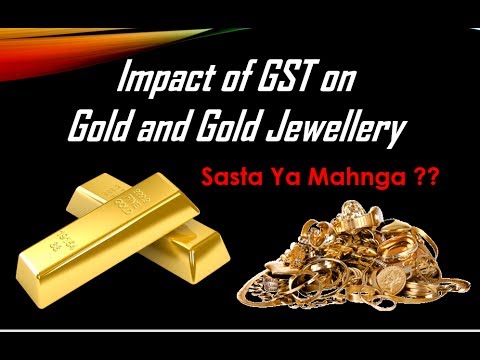GST on Gold : Impact of GST on Gold Prices in India
- 16 Aug 24
- 15 mins

GST on Gold : Impact of GST on Gold Prices in India
- What is GST on Gold?
- GST and Customs Duty on Gold Imports
- Impact of GST on Gold Imports
- What Are the Different Gold GST Rates?
- Overview of Revised Tax Rates on Gold Jewellery
- Impact of GST on Gold Jewellery Prices
- GST Calculation on Gold
- GST on Gold Exemptions
- Things to Consider Before Buying Gold Ornaments
- Comparison of Jewellery Prices Before and After GST
- Conclusion
Key Takeaways
- The GST rate on gold jewelry is 3% on the gold value and 5% on making charges.
- GST applies uniformly to all forms of gold, including jewelry, coins, and raw gold.
- Exemptions from GST are available for personal gold resale and specific gold coins.
- GST has effectively reduced gold smuggling by enforcing stricter regulations and controls.
- Economic policies and market conditions may influence future changes in GST rates for gold.
Gold not only captivates with its luster but also plays a crucial role in the financial portfolios of many as it's purchased for investment purposes too in India. With the implementation of the Goods and Services Tax (GST) in India, the taxation of gold underwent significant changes. Understanding these changes is essential for both consumers and investors in the gold market, as the applicable gold GST rate is separate for precious and semi precious stones in gold jewellery.
What is GST on Gold?

GST (Goods and Service Tax) on gold is a tax imposed on the purchase and sale of gold and gold-related items in India. The GST system, implemented in July 2017, aimed to unify and streamline the taxation process across the country, replacing multiple indirect taxes and duties that were previously applicable.
GST and Customs Duty on Gold Imports
When gold is imported into India, it is subject to both basic customs duty and GST. The customs duty is charged at the point of entry and is separate from the GST. As of the most recent updates, the basic customs duty on gold stands at approximately 10%.
Following the imposition of customs duty, GST is levied at 3% on the aggregate value, which includes the cost of gold plus the customs duty. This cumulative taxing framework ensures that imported gold bears a tax burden similar to that of gold purchased within India, thereby maintaining a level playing field between domestic and imported gold jewellery.
Calculation of GST on Imported Gold
To understand the financial impact of GST on imported gold, consider the following calculation:
- Cost of Gold: Assume the gold import rate is ₹100,000.
- Customs Duty: At 10%, the customs duty would be ₹10,000.
- Total Cost Post-Customs: The total cost of gold after customs duty would be ₹110,000.
- GST at 3%: GST is then applied on the total cost post-customs, which would be 3% of ₹110,000, amounting to ₹3,300.
Therefore, the total cost of importing gold would be ₹113,300.
Rationale Behind GST on Imported Gold
The rationale for imposing GST on imported gold is multifaceted:
- Revenue Generation: It serves as a significant revenue stream for the government.
- Market Regulation: It helps regulate the gold market by ensuring that imported gold is not substantially cheaper than domestically sourced gold, which supports local miners and traders.
- Transparency and Uniformity: Applying GST on imports promotes transparency and uniformity in the taxation system, making it easier for businesses and consumers to understand their tax obligations.
Impact of GST on Gold Imports
The implementation of GST on gold imports has several implications:

Cost Implication for Consumers and Traders: The additional tax increases the overall cost of imported gold, which can influence the buying decisions of consumers and traders.
- Reduced Smuggling: The comprehensive taxation of legal imports helps in curbing gold smuggling by reducing the price differential between legally imported and smuggled gold.
- Influence on Domestic Market: By making imported gold more expensive, GST also indirectly supports the domestic gold industry, as it becomes more competitive against foreign gold.
What Are the Different Gold GST Rates?
The rate of gst is multi-faceted, involving various components:
- 3% GST on gold value of the jewellery.
- 5% GST on making charges, if applicable.
Overview of Revised Tax Rates on Gold Jewellery
Under GST, gold jewellery is subject to a gold tax rate that combines multiple components. Here’s a breakdown of how these components apply:
GST on Gold Content: The base metal itself, which is the gold used in the jewellery, is taxed at 3%. This rate applies regardless of the form of the gold—be it gold bars, gold coins, physical gold or jewellery.
GST on Making Charges: The labour charges involved in creating gold jewellery, known as making charges, are taxed separately at a rate of 5%. This is a significant aspect because making charges can vary greatly depending on the type of jewellery and the craftsmanship involved.
Impact of GST on Gold Jewellery Prices
The implementation of GST on gold jewellery brought about a slight increase in the overall types of taxes burden compared to the previous tax system. Before GST, consumers typically paid a total of about 2% in taxes, including 1% Value Added Tax (VAT) and 1% excise duty. With the introduction of GST, the combined rate (3% on gold plus 5% on making charges) resulted in a approximate increase in the total cost of purchasing gold jewellery.
Rationale Behind the Revised Rates
The rationale for revising the tax rates under GST for gold jewellery includes:
- Simplification: By consolidating various taxes into a single framework, GST simplified the tax structure, making it easier for both buyers and sellers to manage their finances.
- Transparency: GST has increased transparency in the pricing of gold jewellery. Customers now have a clearer breakdown of what they are paying for—the gold content and the craftsmanship.
- Regulation: The standardized rates help regulate the gold market, reducing disparities caused by the previously varied state-level taxes.
- Boost to Formal Economy: With clearer tax structures, more aspects of gold transactions are recorded formally, which helps in curbing the black market and increasing government revenues from the gold jewellery sector.
Input Tax Credit (ITC) Advantages
One of the advantages of the GST system is the availability of Input Tax Credit (ITC). This feature allows jewelers to claim a credit for the GST paid on inputs (like raw gold and other materials) used in the production of jewellery. This helps offset the overall tax liability, potentially reducing the cost to the consumer and encouraging compliance with tax regulations.
GST Calculation on Gold
Calculating GST on gold involves understanding how the tax is applied to both the raw material itself and the additional costs associated with manufacturing and selling gold items, such as jewellery. In India, GST is imposed at different rates on the value of the gold and on the making charges, which are the costs involved in crafting the jewellery. Here’s a step-by-step breakdown of how GST is calculated on gold, particularly gold jewellery.
Components of GST Calculation on Gold
- GST on the Gold Content: The rate of GST applied to the gold content (the raw metal) is 3%. This applies to the total cost of the gold used in the jewellery.
- GST on Making Charges: The gold making charges, which cover the labour involved in creating the jewellery, are taxed at a higher rate of 5%.
Step-by-Step GST Calculation
To illustrate how GST is calculated on gold, let’s consider a practical example:
Price of Gold: Suppose the price of gold jewellery is ₹50,000 per 10 grams.
Making Charges: Assume the making charges on gold jewellery made from these 10 grams of gold are ₹5,000.
Calculate GST on Gold Content:
Total price of gold = ₹50,000
GST at 3% on ₹50,000 = ₹50,000 x 0.03 = ₹1,500
Calculate GST on Making Charges:
Total making charges = ₹5,000
GST at 5% on ₹5,000 = ₹5,000 x 0.05 = ₹250
Total GST Payable:
Total GST on gold content = ₹1,500
Total GST on making charges = ₹250
Total GST payable = ₹1,500 + ₹250 = ₹1,750
Final Price Calculation:
Total price of gold without GST = ₹50,000
Total making charges without GST = ₹5,000
Total cost before GST = ₹50,000 + ₹5,000 = ₹55,000
Total GST = ₹1,750
Total cost including GST = ₹55,000 + ₹1,750 = ₹56,750
Key Points to Remember in GST Calculation on Gold
- Input Tax Credit (ITC): Businesses can claim ITC on the GST paid on input credit used in the making charges of gold jewellery. This can offset the GST payable on the final product, potentially reducing the overall cost.
- Transparency: GST on gold and making charges ensures transparency in the gold price of jewellery, which helps customers understand the breakdown of what they are paying.
- Compliance: It's crucial for businesses to comply with GST regulations, including the proper calculation and remittance of GST on both gold and the associated making charges.
GST on Gold Exemptions

The Goods and Services Tax (GST) in India, introduced in July 2017, generally applies to the sale and purchase of gold and gold-related products. However, there are specific exemptions within the GST framework that apply to certain transactions involving gold.
Understanding these exemptions is important for both consumers and businesses to navigate the tax implications effectively. Key Exemptions for GST on Gold
- Gold Supplied by a Nominated Agency
Under the GST regime, gold bullion supplied by nominated agencies to registered jewelers is exempt from GST. Nominated agencies include public sector banks, private banks, and other entities authorized by the Reserve Bank of India to import gold and supply it to jewelers. This exemption is designed to facilitate the supply chain of gold without additional tax burdens.
- Re-Sale of Personal Gold
Individuals selling old gold jewellery or gold items are not required to charge GST on the transaction, as this falls under the category of selling second-hand goods. This exemption is significant because it ensures that individuals are not financially penalized for selling personal assets that have already been subjected to GST at the time of initial purchase.
- Export of Gold Jewellery
Gold jewellery and other gold items that are exported out of India are zero-rated under GST. This means that while GST is applicable, the rate is effectively zero, and jewellery exporters can claim a refund on the input tax credit (ITC) for taxes paid on inputs used to manufacture the exported goods. This exemption is critical for promoting the export of gold jewellery, which is a significant component of India’s export economy.
- Supply to SEZs
Supplies of gold to Special Economic Zones (SEZs) are treated as zero-rated supplies. Businesses supplying gold to units in SEZs do not charge GST on these supplies, but they can claim ITC on the input taxes paid, fostering trade and investment within SEZs.
Considerations for GST Exemptions on Gold
- Documentation and Compliance: To benefit from GST exemptions, proper documentation and compliance are essential. For example, exporters of gold jewellery must provide proof of export within the prescribed time to qualify for zero-rated GST and claim refunds on input taxes.
- Monitoring and Regulation: The Indian government closely monitors transactions involving GST exemptions to prevent misuse. Businesses and individuals must ensure all conditions are met to legitimately avail of these exemptions.
- Market Impact: These exemptions play a crucial role in maintaining the liquidity and stability of the gold market in India. By exempting certain transactions from GST, the government helps stabilize price rise and encourages activities that contribute positively to the economy.
Things to Consider Before Buying Gold Ornaments
When considering the purchase of gold ornaments, there are several important factors to keep in mind. These considerations ensure you make a wise investment and choose pieces that meet your expectations in terms of quality, value, and style. Here’s a comprehensive guide to what you should consider before buying gold jewellery.

- Purity of Gold
One of the first and most crucial factors to consider is the purity of the gold. Gold purity is measured in karats, with 24-karat gold being the purest form. However, because pure gold is soft and malleable, it's often alloyed with other metals for use in jewellery, making 22-karat or 18-karat gold common for ornaments. Always check the karat rating to ensure you are getting the quality you pay for.
- Hallmark Certification
To guarantee the purity of gold, look for hallmarked gold jewellery with proper certification. A hallmark is a mark or a series of marks made on gold jewellery by the official assaying centers to certify the gold content. In many countries, including India, hallmarking gold jewellery is mandatory. The hallmark gold includes the BIS mark, the purity/fineness grade, and the assaying center's identification mark.
- Making Charges
The cost of making gold jewellery can vary significantly based on the design and intricacy. Making charges are usually a percentage of the current gold rate. Therefore, more intricate designs lead to higher charges. It’s advisable to discuss making charges and understand how they affect the overall cost before finalizing a gold purchase.
- Check for Buyback Terms
Understanding the buyback terms of the jewellery store can be crucial, especially if you plan to upgrade or exchange your gold ornaments in the future. Some jewelers offer a buyback policy at market rates for both the metal and the making charges, while others may deduct a certain percentage.
- Comparison Shopping
Gold prices can fluctuate, and different jewelers may offer varying rates and making charges. It's wise to shop around and compare prices from multiple jewelers to find the best deal. Also, consider visiting both local stores and reputable online platforms to broaden your options.
- Read Reviews and Gather Recommendations
Before making a purchase, especially from a new jeweler, read customer reviews and ask for recommendations from trusted sources. This can help you gauge the reliability and quality of the jeweler’s products and customer service.
- Understand the GST Impact
Since the implementation of the Goods and Services Tax (GST), the cost of buying gold jewellery has been impacted by additional taxes on the price of gold itself and the making charges. Understand how much GST will be charged on your purchase as this affects the total cost.
- Weight of Gold
The weight in gram price of the gold in your jewellery will significantly influence the price. More substantial pieces not only cost more but also retain more intrinsic value. Ensure that the weight and price correlate correctly with the carat gold purity.
- Future Resale Value
Consider the resale value of the gold ornaments you purchase. Some styles and designs are timeless and may have better resale value compared to trendier items. Classic designs typically retain more value over time.
- Insurance for Gold Ornaments
For high-value purchases, consider getting insurance for your gold jewellery. This protects against risks such as theft or accidental loss. Check with your insurance provider about specific coverage options available for jewellery.
By keeping these considerations in mind, you can make a more informed and satisfactory purchase of gold ornaments, ensuring both the quality of the investment and the enjoyment of wearing fine jewellery.
Comparison of Jewellery Prices Before and After GST
When comparing jewellery prices before and after the implementation of GST (Goods and Services Tax) in India, it's evident that the tax reform has had a notable impact on the pricing structure. Here's a detailed tabular comparison illustrating how jewellery prices have changed due to GST, considering various aspects such as the cost of raw gold, making charges, and overall pricing.
| Component | Pre-GST Era | Post-GST Era |
|---|---|---|
| Basic Cost of Gold | Subject to 1% VAT (Value Added Tax) plus 1% excise duty, totaling around 2%. | Now uniformly taxed at 3% under GST. |
| Making Charges | Typically, it is subject to 1% VAT only, depending on the state. | Taxed at 5% under GST, which is generally higher than previous VAT rates on making charges. |
| Overall Tax Burden | Varied significantly from state to state, leading to discrepancies in jewellery prices across regions. | Uniform GST rate across all states, leading to a more predictable pricing structure nationwide. |
| Input Tax Credit | Not available under the old tax regime, leading to a cascading effect of taxes. | Available under GST, which can reduce the cost for jewelers and potentially for buyers as well. |
| Price Transparency | Often less transparent due to varying state taxes and hidden charges. | Improved transparency with GST breakdowns on invoices, making it easier for consumers to understand. |
| Export Duty | Exports were generally exempt from VAT but could incur other duties. | Exports of jewellery are zero-rated under GST, allowing indian exporters to claim refunds on inputs. |
| Compliance and Regulation | Often complicated due to differing state laws and regulations. | Simplified through a unified system under GST, enhancing compliance and reducing administrative burdens. |
Conclusion
The introduction of GST on gold has brought about significant changes to the jewellery market in India. While the initial impact included a hike in prices, the long-term benefits include greater transparency and a more regulated market.
💡Missing the deadline to pay GST payments? Download Pice and start using a credit card to pay GST on time, experience efficiency and convenience, and manage cash flow more effectively.




















